Glenugie Peak
Glenugie Peak, also known as Mount Elaine or as Glen Ugie Peak,[1] a mountain that is part of the ridge surrounding the Clarence Moreton Basin, is situated in the Northern Rivers region of New South Wales, Australia. At an elevation of 316 metres (1,037 ft) above sea level, the mountain is located near the Pacific Highway, south of the town of Grafton and approximately 6 kilometres (3.7 mi) west north-west of the locality of Calamia.
| Glenugie Peak | |
|---|---|
| Mount Elaine Glen Ugie Peak[1] | |
 Glenugie Peak with eastern grey kangaroos (at bottom left) | |
| Highest point | |
| Elevation | 316 m (1,037 ft) |
| Coordinates | 29°50′0″S 153°03′48″E[1] |
| Geography | |
 Glenugie Peak Location in New South Wales | |
| Location | Northern Rivers region, New South Wales, Australia |
| Geology | |
| Age of rock | Cenozoic |
| Mountain type | Dolerite |
Glenugie Peak is known as Gunayjun to the local Gumbaynggirr people[2]
Features and location
It is a dolerite peak[3] from the Cenozoic era extruded from the Grafton Formation. The Grafton Formation is a series of sedimentary rocks, laid down between the late Jurassic and early Cretaceous periods.
Glenugie Peak is noted by Matthew Norman for its dry rainforest in a gully which includes a number of rare species of trees, as well as the Yellow Box, which is more often associated with areas west of the Great Dividing Range.[4] Average annual rainfall is 1,138 millimetres (44.8 in).[3]
Glenugie peak rock was used as ballast for the North Coast railway line and remnants of the tramway used to transport the rock can be seen today.[5]
See also
- List of mountains in New South Wales
References
- "Glenugie Peak". Geographical Names Register (GNR) of NSW. Geographical Names Board of New South Wales. Retrieved 13 May 2015.

- "Gumbaynggirr Language" (PDF).
- Floyd, A. G. (1989). Rainforest Trees of Mainland South-eastern Australia. Inkata Press. p. 76. ISBN 0-909605-57-2.
- "Secrets of a Basalt Hill". NSW Department of Industry and Investment. Archived from the original on 21 March 2011. Retrieved 6 December 2010.
- "29 Mar 1913 - GLENUGIE QUARRY. - Trove". Nla.gov.au. 29 March 1913. Retrieved 25 February 2016.